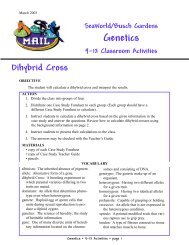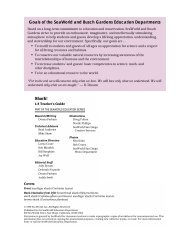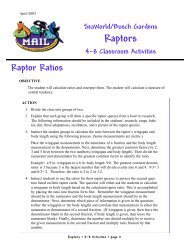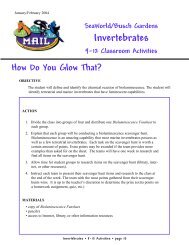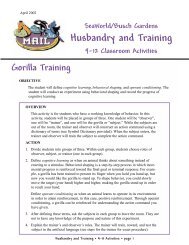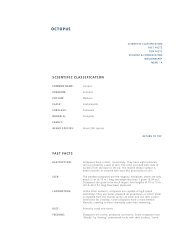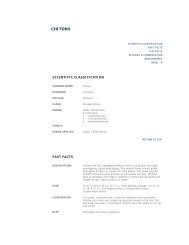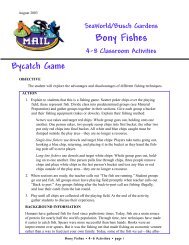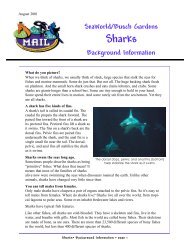Invertebrate Survivor - Sea World
Invertebrate Survivor - Sea World
Invertebrate Survivor - Sea World
Create successful ePaper yourself
Turn your PDF publications into a flip-book with our unique Google optimized e-Paper software.
January/February 2004<br />
<strong>Invertebrate</strong> <strong>Survivor</strong><br />
OBJECTIVE<br />
ACTION<br />
<strong>Sea</strong><strong>World</strong>/Busch Gardens<br />
<strong>Invertebrate</strong>s<br />
9-12 Classroom Activities<br />
The student will correlate genus and species name with the common name of various invertebrates.<br />
The student will identify the anatomy of an invertebrate. The student will identify various facts<br />
about invertebrates.<br />
1. Divide the class into two equal groups. The two teams should be even, if there is an<br />
odd number of students have one of them volunteer to help the teacher run the game.<br />
2. Ask each team to name themselves after an invertebrate.<br />
3. Explain the rules of play as follows: The two teams will play against one another.<br />
There will be a series of <strong>Invertebrate</strong> challenges. If a team wins a challenge, they do<br />
not have to vote any of their fellow teammates out of the game. However, if a team<br />
loses a challenge, they must vote some of their teammates out of the game. The<br />
number of students voted out after each challenge will depend on the size of the<br />
class. The voting instructions listed below gives instructions on how to calculate how<br />
many students should be eliminated after each challenge according to class size. The<br />
students that are voted out of the game will have a seat on the judges’ panel.<br />
Eventually the panel of judges will determine the final winner of <strong>Invertebrate</strong><br />
<strong>Survivor</strong>. During a voting session, each student can ONLY vote for someone else,<br />
they CANNOT vote for themselves.<br />
Voting Instructions<br />
These voting instructions are for a class of 24 students. However, any size class can<br />
be adapted into this model by modifying the number of people that are eliminated<br />
during the first three challenges and the last three. Generally, with class sizes larger<br />
than 24 students, more than three students should be eliminated after each challenge.<br />
Conversely, with a class smaller than 24 students, less than three students should be<br />
eliminated after each challenge. The merge between the two teams is after the third<br />
challenge and there shouldn’t be more than five candidates for the judges to choose<br />
from after the sixth challenge.<br />
Class size of 24: The team that loses a challenge will vote THREE members out of<br />
the game. Once the total number of students from both teams is 15 (this will happen<br />
after the third challenge), the two teams will merge into one new team. Together the<br />
<strong>Invertebrate</strong>s • 9-12 Activities • page 1
new team will decide on another invertebrate name to call themselves. The next series<br />
of challenges (four through six) are going to be evaluated on an individual basis.<br />
FOUR students will be eliminated from the game after each challenge. The students<br />
are not voted out by their fellow teammates at this point, they are eliminated if they<br />
come into the last four places from each challenge. After the sixth challenge, there<br />
should be three students left. The judges’ panel will determine from those three who<br />
becomes the <strong>Invertebrate</strong> survivor.<br />
4. Begin the game by starting the first challenge. Refer to the first challenge’s directions<br />
and instruct students accordingly. The answers may be checked by using the<br />
Teacher’s Guide. The voting process begins for the team who loses the challenge.<br />
The voting process is initiated by every team member writing down three of their<br />
teammates names that they feel should be eliminated from the game. Votes should be<br />
cast confidentially. The three people that receive the most votes are eliminated.<br />
In the event of a tie, the decision will be determined by the <strong>Invertebrate</strong> Spelling<br />
Challenge. The students that are involved in the tie will draw an invertebrate name<br />
and have to spell it backwards(without reading their slips of paper). The word must<br />
be spelled correctly the first time. The student(s) (depending on how many elimination<br />
spaces have to be filled) that spell their word the slowest or do not spell it<br />
correctly the first time are eliminated.<br />
5. Repeat step 4 for challenge two and challenge three.<br />
6. Merge the two groups together after the third challenge (when the two groups together<br />
equal 15). The team should rename themselves since they are a new group.<br />
7. Explain that the rest of the challenges are going to be conducted on an individual<br />
basis and instead of three eliminations after each challenge there are now four! The<br />
team members that fall into the last four places with each challenge are eliminated.<br />
The answers to the challenges are in the Teacher’s Guide. This process is repeated for<br />
challenges four through six. In the event of a tie, the <strong>Invertebrate</strong> Spelling Challenge<br />
is conducted to make the decision.<br />
8. The sixth challenge is the last event and the students remaining after the elimination<br />
are considered to be “invertebrate finalists.” (There should be three students left if the<br />
class started with 24 students).<br />
9. Instruct the invertebrate finalists to make a 1-minute speech to the judging panel<br />
about why they should be the sole <strong>Invertebrate</strong> <strong>Survivor</strong>. The judges will cast their<br />
votes for the student they think should be the SOLE <strong>Invertebrate</strong> <strong>Survivor</strong>.<br />
MATERIALS<br />
Per class:<br />
• copy of Challenge Packet (see Preparation)<br />
• one Teacher’s Guide<br />
• two stop watches<br />
• one pencil per student<br />
• one <strong>Invertebrate</strong> Spelling Challenge<br />
Funsheet<br />
• large bowl<br />
REPARATION<br />
Make the following copies of the<br />
Challenge Packet:<br />
• 2 copies of Challenges 1-3<br />
• 12 or more copies (half class size) of<br />
Challenges 4-6<br />
Cut and fold the names from the<br />
<strong>Invertebrate</strong> Spelling Challenge Funsheet<br />
and place them in a bowl for the random<br />
drawing. This is used in the event of a tie.<br />
<strong>Invertebrate</strong>s • 9-12 Activities • page 2 © 2004 Busch Gardens
CRYPTO-FACT<br />
Hints:<br />
Challenge 1<br />
Directions: The following facts are related to various invertebrates. However, these<br />
facts are written in code where one letter actually stands for another. Listed below<br />
are a few hints to help solve the CRYPTO-FACT. The team that solves the most<br />
CRYPTO-FACTS in ten minutes wins the challenge!<br />
· The letter "O" in the CRYPTO-FACT stands for the letter "T"<br />
· The letter "M" in the CRYPTO-FACT stands for the letter "X"<br />
· The letter "U" in the CRYPTO-FACT stands for the letter "G"<br />
· The letter "R" in the CRYPTO-FACT stands for the letter "E"<br />
· The length and formation of the words are all hints.<br />
· If you solve one of the CRYPTO-FACTS, the letters from that fact can be used to<br />
determine all the others since all the facts have the same code.<br />
1. VIERTOE ZPKR OZNRR QJSG ERUDRIOE TPWWRS ZRPS, OZJNPM, PIS<br />
PQSJDRI.<br />
__ __ __ __ __ __ __ __ __ __ __ __ __ __ __ __ __ __ __ __ __ __ __ __ __ __ __ __<br />
__ __ __ __ __ __ __ __ __ __, __ __ __ __ __ __, __ __ __ __ __ __ __ __ __ __ .<br />
2. YWRPE PNR LVIUWREE.<br />
__ __ __ __ __ __ __ __ __ __ __ __ __ __ __ __.<br />
3. EAVSRNE ZPKR OLJ QJSG ERUDRIOE TPWWRS TRAZPWJOZJNPM PIS<br />
PQSJDRI.<br />
__ __ __ __ __ __ __ __ __ __ __ __ __ __ __ __ __ __ __ __ __ __ __ __ __ __<br />
__ __ __ __ __ __ __ __ __ __ __ __ __ __ __ __ __ __ __ __ __ __<br />
__ __ __ __ __ __ __.<br />
4. PNOZNJAJSE ZPKR RMJECRWROJIE, XJVIORS WRUE, PIS ERU-<br />
DRIORS QJSVRE.<br />
__ __ __ __ __ __ __ __ __ __ __ __ __ __ __ __ __ __ __ __ __ __ __ __ __ __,<br />
__ __ __ __ __ __ __ __ __ __ __, __ __ __ __ __ __ __ __ __ __ __ __ __ __<br />
__ __ __ __.<br />
5. ZJWRE VI OZR RMJECRWROJI BERS YJN NREAVNPOVJI PNR<br />
TPWWRS EAVNPTWRE.<br />
__ __ __ __ __ __ __ __ __ __ __ __ __ __ __ __ __ __ __ __ __ __ __ __<br />
__ __ __ __ __ __ __ __ __ __ __ __ __ __ __ __ __ __ __ __ __ __ __ __<br />
__ __ __ __ __ __ __ __ __.<br />
<strong>Invertebrate</strong>s • 9-12 Activities • page 3 © 2004 Busch Gardens
Challenge 2<br />
Directions: Label the fly diagram with their corresponding parts listed below. The<br />
team that has the most correct matches in five minutes wins the challenge.<br />
abdomen head<br />
antenna mandibles<br />
compound eye leg<br />
wing thorax<br />
simple eye<br />
<strong>Invertebrate</strong>s • 9-12 Activities • page 4 © 2004 Busch Gardens
Challenge 3<br />
Directions: Answer the following questions.The team that has the most correct answers<br />
in 10 minutes wins, the challenge.<br />
1. Praying mantises belong to what phyla?<br />
A. Chordata<br />
B. Arthropoda<br />
C. Mollusca<br />
D. Lycopodiophyta<br />
2. Which of the following is the smallest insect?<br />
A. hairy winged beetle<br />
B. ladybug<br />
C. fruit fly<br />
D. katydid<br />
3. What are the three main body parts of<br />
an insect?<br />
A. eye, head, and abdomen<br />
B. brain, thorax, and abdomen<br />
C. head, antennae, and thorax<br />
D. head, thorax, and abdomen<br />
4. How many legs does an insect have on<br />
its thorax?<br />
A. two<br />
B. four<br />
C. six<br />
D. eight<br />
5. All of the following are insects EXCEPT?<br />
A. pillbug<br />
B. dragonfly<br />
C. mosquito<br />
D. lubber<br />
6. The class Chelicerata includes all of the<br />
following EXCEPT.<br />
A. scorpions<br />
B. spiders<br />
C. horseshoe crabs<br />
D. hermit crabs<br />
7. The only arthropods that lack antennae<br />
belong to which group of animals?<br />
A. Myriapoda<br />
B. Chelicerata<br />
C. Crustacea<br />
D. Insecta<br />
8. Tape worms and flat worms belong to what<br />
phlya?<br />
A. Platyhelminthes<br />
B. Annelida<br />
C. Cnidaria<br />
D. Porifera<br />
9. The exoskeleton of an invertebrate<br />
comprises all of the following<br />
EXCEPT?<br />
A. sclerotin<br />
B. wax<br />
C. chitin<br />
D. keratin<br />
10. Spiracles (holes in the exoskeleton)<br />
open to the tracheal tube for which of<br />
the following purposes?<br />
A. digestion<br />
B. respiration<br />
C. excretion<br />
D. sensation<br />
11. All of the following insects vary in<br />
color from males to females EXCEPT?<br />
A. dragonflies<br />
B. sawflies<br />
C. grasshoppers<br />
D. ladybugs<br />
12. Which of the following tells the 4<br />
stages of complete metamorphosis?<br />
A. egg, nymph, cocoon, adult<br />
B. egg, larva, pupa, adult<br />
C. egg, cocoon, pupa, adult<br />
D. egg, pupa, juvenile, adult<br />
13. All of the following are useful products<br />
that insects make EXCEPT?<br />
A. Silk<br />
B. Plastic<br />
C. Shellac<br />
D. Wax<br />
14.Which of the following is an example<br />
of incomplete metamorphosis?<br />
A. mealworm to beetle<br />
B. caterpillar to butterfly<br />
C. juvenile roach to winged adult<br />
D. egg to honeybee<br />
15.Which of the following is an advantage<br />
to having an exoskeleton?<br />
A. prevents water loss<br />
B. provides attachment for muscles<br />
C. Provides expansion<br />
capabilities for growth<br />
D. both A and B<br />
<strong>Invertebrate</strong>s • 9-12 Activities • page 5 © 2004 Busch Gardens
Challenge 4<br />
Directions: Some invertebrates are beneficial to environment while others could be<br />
harmful. Match the benefit or problem from column A to their corresponding invertebrate<br />
in column B by drawing a line. Note: Some benefits or problems in Column A<br />
may use more than one answer in Column B. The students that have the most correct<br />
matches in five minutes will move onto the next round.<br />
COLUMN A COLUMN B<br />
bubonic plague Tsetse fly (Genus: Glossina)<br />
Lyme disease Trypanosoma cruzi (protozoan)<br />
flower pollinator Black Widow Spider (Latrodectus hesperus)<br />
malaria Bumblebee (Bombus morrisoni)<br />
yellow fever Ladybug (Coccinella septempunctata)<br />
If bitten, toxin attacks Corkscrew-shaped bacteria carried by<br />
the nervous system the black-legged tick (Ixodes scapularis)<br />
predator of more harmful insects Flea (Xenopsylla cheopis)<br />
sleeping sickness Butterfly (Danaus plexippus)<br />
encephalitis Mosquito (Genus: Aedes)<br />
American Trypanosomiasis or Mosquitos in the Genera Aedes and<br />
Chagas’ Disease Culex<br />
Praying Mantis (Tenodera aridifolia sinensis)<br />
Protozoans that are transmitted by the<br />
Anopheles mosquito<br />
<strong>Invertebrate</strong>s • 9-12 Activities • page 6 © 2004 Busch Gardens
Challenge 5<br />
Directions: Even though about 90% of the world’s animal species are invertebrates,<br />
some invertebrate populations are at risk for becoming extinct. Identify each insect listed<br />
below as either at risk (“R”) or common (“C”) by writing the initial in the blank provided.<br />
The students that have the most correct answers in five minutes will move onto the<br />
next round.<br />
INSECT LIST<br />
1. American burying beetle, Nicrophorus americanus _____<br />
2. Delta green ground beetle, Elaphrus viridis _____<br />
3. Two-lined Spittlebug, Prosapia bicincta _____<br />
4. Northeastern beach tiger beetle, Cicindela dorsalis dorsalis _____<br />
5. Puritan tiger beetle, Cicindela puritana_____<br />
6. Tooth cave beetle, Rhadine persephone _____<br />
7. Southeastern lubber, Romalea microptera _____<br />
8. Bay checkerspot butterfly, Euphydryas editha bayensis _____<br />
9. Corsican swallowtail, Papilio hospiton _____<br />
10. Desert Locust, Schistocerca gregaria _____<br />
11. Homerus swallowtail, Papilio homerus _____<br />
12. Karner blue butterfly, Lycaeides melissa samuelis _____<br />
13. Lange's metalmark butterfly, Apodemia momio langei _____<br />
14. Earwig, Forticula auricularia _____<br />
15. Luzon peacock swallowtail, Papilio chikae _____<br />
16. Spotted snake millipede, Blaniulus guttulatus _____<br />
17. Chinese praying mantis, Tenodera aridifolia _____<br />
18. Myrtle's silverspot, Speyeria zerene myrtleae _____<br />
19. Oregon silverspot butterry, Speyeria zerene hippolyta _____<br />
20. Palos Verdes blue, Glaucopsyche lygdamus palosverdesensis _____<br />
21. Queen Alexandra's birdwing, Ornithoptera alexandrae _____<br />
22. San Bruno elfin butterfly, Incisalia mossii bayensis _____<br />
23. Linearwinged grasshopper, Aptenopedes sphenariodes _____<br />
24. Southeastern field cricket, Gryllus rubens _____<br />
25. <strong>Sea</strong>side earwig, Anisolabis maritima _____<br />
26. African millipede, Archespirostreptus sp. _____<br />
27. Ash meadows naucorid, Ambrysus amargosus _____<br />
28. Madagascar hissing cockroach, Gromphadorhina portentosa _____<br />
29. Delhi sands flower-loving fly, Rhaphiomidas terminatus abdominalis _____<br />
30. Monarch Butterfly, Danaus plexippus _____<br />
31. Vivid Dancer, Argia vivida _____<br />
32. Ground Mantid, Litaneutria minor _____<br />
33. Ground-hopper, Tetrix undulata _____<br />
34. Robber Fly, Megaphorus willistoni _____<br />
35. Quiet-calling katydids, Meconema thalassinum _____<br />
36. Viceroy, Limenitis archippus _____<br />
37. Emperor Scorpion, Pandinus imperator _____<br />
<strong>Invertebrate</strong>s • 9-12 Activities • page 7 © 2004 Busch Gardens
Challenge 6<br />
Directions: Match the common name in the left column to its genus species name in the<br />
right column by number. The students with the most correct matches will prepare to<br />
make their speeches about “Why They Should Become the Sole <strong>Invertebrate</strong> <strong>Survivor</strong>.”<br />
Example: human __21_ 21) Homo sapien<br />
COMMON NAME GENUS SPECIES<br />
bumblebee _____ 1) Somatochlora incurvata<br />
butterfly _____ 2) Aphonopelma chalcodes<br />
ant _____ 3) Pandinus imperator<br />
dragonfly _____ 4) Romalea microptera<br />
scorpion _____ 5) Henricia aspera<br />
praying mantis _____ 6) Scarabaeus sacer<br />
ladybug _____ 7) Latrodectus mactans<br />
tarantula _____ 8) Photinus pyralis<br />
lobster _____ 9) Melanoplus regalis<br />
lubber _____ 10) Bombus morrisoni<br />
millipede _____ 11) Coccinella septempunctata<br />
dung beetle _____ 12) Strongylocentrotus franciscanus<br />
cockroach _____ 13) Gromphadorhina portentosa<br />
earthworm _____ 14) Cirripedia verrucomorpha<br />
firefly _____ 15) Danaus plexippus<br />
black widow spider _____ 16) Scaphiostreptus paralis acuticonus<br />
grasshopper _____ 17) Homarus americanus<br />
sea star _____ 18) Tetramorium caespitum<br />
barnacle _____ 19) Allolobophora chlorotica<br />
sea urchin _____ 20) Tenodera aridifolia sinensis<br />
<strong>Invertebrate</strong>s • 9-12 Activities • page 8 © 2004 Busch Gardens
<strong>Invertebrate</strong> Spelling Challenge Funsheet<br />
invertebrate mosquito<br />
ladybug millipede<br />
dragonfly butterfly<br />
praying mantis bumblebee<br />
scorpion tarantula<br />
earthworm lobster<br />
caterpillar cricket<br />
insect arthropod<br />
sea anemone horsefly<br />
<strong>Invertebrate</strong>s • 9-12 Activities • page 9 © 2004 Busch Gardens
Teacher's Guide<br />
Challenge 1 Answers<br />
1. Insects have three body segments called head, thorax, and abdomen.<br />
2. Fleas are wingless.<br />
3. Spiders have two body segments called cephalothorax and abdomen.<br />
4. Arthropods have exoskeletons, jointed legs, and segmented bodies.<br />
5. Holes in the exoskeleton used for respiration are called spiracles.<br />
Challenge 2 Answers<br />
· Abdomen: Last of three segments of a fly.<br />
· Antenna: One of two sensory appendages attached to the head of flies.<br />
· Compound Eye: One of two large eyes that are composed of many hexagonal lenses.<br />
· Wing: One of the two large, upper wings that are attached to the thorax.<br />
· Head: The head is the part of the fly that contains the brain, eyes, mandibles, and<br />
antennae.<br />
· Mandibles: a pair of jaws located on the lower sides of the head. Mandibles are used<br />
to carry objects and bite.<br />
· Simple Eye: Small eyes located between the compound eyes. These eyes detect light<br />
from dark.<br />
· Thorax: The mid-body segment between the head and abdomen.<br />
· Legs: Insects have 6 jointed legs attached to the thorax.<br />
antennae<br />
head<br />
simple eye<br />
thorax<br />
abdomen<br />
leg<br />
mandible<br />
compound eye<br />
wing<br />
<strong>Invertebrate</strong>s • 9-12 Activities • page 10 © 2004 Busch Gardens
Challenge 3 Answers<br />
1. Which of the following Phylums do praying mantises belong to?<br />
B. Arthropoda is the animal phylum in which insects (praying mantis), spiders,<br />
crustaceans, spiders, scorpions, and centipedes belong. They have exoskeletons,<br />
jointed legs, and segmented bodies.<br />
Chordata is the animal phylum in which humans and many other vertebrates belong.<br />
Lycopodiophyta is the phylum in which vascular plants belong. Mollusca is the in<br />
which phylum of soft-bodied un-segmented animals belong.<br />
2. Which of the following is the smallest insect?<br />
Some of the A. hairy winged beetles are barely one-hundredth of an inch in length<br />
and they are smaller than a ladybug or fruit fly.<br />
3. What are the three main body parts of an insect?<br />
D. Head, thorax, and abdomen<br />
4. How many legs does an insect have on its thorax?<br />
C. Six<br />
5. The exoskeleton of an invertebrate comprises all of the following EXCEPT?<br />
D. Keratin. Many vertebrates have their hair, nails, scales, etc. comprised out of<br />
keratin. Sclerotin has proteins, wax prevents water loss, and chitin is durable<br />
substance that creates the hard surface of arthropods.<br />
6. Spiracles (holes in the exoskeleton) open to the tracheal tube for which of the<br />
following purposes?<br />
B. Respiration. The spiracles’ function is for respiration.<br />
7. All of the following are insects EXCEPT?<br />
A. Pillbugs. Pillbugs are not insects, they are belong to the class crustacea. In general<br />
insects are composed of three body segments (head, thorax, and abdomen), three<br />
pairs of legs, and two pairs of wings.<br />
8. The class Chelicerata includes all of the following EXCEPT.<br />
D. Hermit crabs Hermit crabs belong to the class crustacea because they are true<br />
crabs.<br />
9. The only arthropods that lack antennae belong to which of the following groups of<br />
animals?<br />
B. Chelicerata. Members of chelicerata (scorpions, spiders, etc.) do not have antennae<br />
and they are the only arthropods that lack them.<br />
10. Tape worms and flat worms belong to which of the following phyla?<br />
A. Platyhelminthes. Sponges belong to the phylum Porifera; jellyfish, corals, and<br />
sea anemones belong to Cnidaria; segmented worms (polychates) belong to the<br />
phylum Annelida.<br />
11. All of the following insects vary in color from males to females EXCEPT?<br />
D. Ladybugs<br />
<strong>Invertebrate</strong>s • 9-12 Activities • page 11 © 2004 Busch Gardens
12. Which of the following represents the 4 stages of complete metamorphosis?<br />
B. Egg, larva, pupa, and adult. Metamorphosis means a change of body form and<br />
appearance. An invertebrate's outer coating is hard and cannot expand as the invertebrate<br />
grows. The coating must split, with a new larger one forming underneath.<br />
Complete metamorphosis has 4 stages of growth, egg, larva, pupa and adult. In complete<br />
metamorphosis the insect changes its shape completely.<br />
13. All of the following are useful products that insects make EXCEPT?<br />
B. Plastic. Plastic is a man-made substance whereas silk, shellac and wax can all be<br />
derived from various types of insects.<br />
14. Which of the following is an example of incomplete metamorphosis?<br />
C. Juvenile roach to winged adult. Incomplete metamorphosis has three stages:<br />
egg, nymph, and adult. The insects hatch from their eggs looking like tiny versions<br />
of the adults. A juvenile roach looks like a tiny version of the winged adult whereas<br />
all the other examples are examples of complete metamorphosis. Complete metamorphosis<br />
involves a distinct change in appearance and form from beginning to end.<br />
15. Which of the following is an advantage to having an exoskeleton?<br />
D. Both A & B. Prevention of water loss and provision for muscle attachment are<br />
both advantages to having exoskeleton. The exoskeleton provides a place for muscle<br />
attachment, allowing much greater leverage than attachment to an internal skeleton.<br />
This explains the apparent greater muscular strength of insects. Once an exoskeleton<br />
is formed and hardened, it is not elastic, and does not allow for growth. It must be<br />
shed and a new larger exoskeleton made.<br />
Challenge 4 Answers<br />
bubonic plague: flea (Xenopsylla cheopis)<br />
malaria: Protozoans that are transmitted by the Anopheles mosquito<br />
Lyme Disease: Corkscrew-shaped bacteria carried by the black-legged tick (Ixodes<br />
scapularis)<br />
If bitten, toxin attacks nervous system: black widow spider (Latrodectus hesperus)<br />
flower pollinator: bumblebee (Bombus morrisoni) and butterfly (Danaus plexippus)<br />
yellow fever: Mosquito (Genus: Aedes)<br />
encephalitis: mosquitos in the Genera Aedes and Culex<br />
sleeping sickness: Tsetse fly (Genus: Glossina)<br />
trypanosomiasis or Chagas’ Disease: Trypanosoma cruzi (protozoan)<br />
acts as a predator of more harmful insects: praying mantis (Tenodera aridifolia sinensis)<br />
and ladybug (Coccinella septempunctata)<br />
<strong>Invertebrate</strong>s • 9-12 Activities • page 12 © 2004 Busch Gardens
Challenge 5 Answers<br />
1. American burying beetle, Nicrophorus americanus, R<br />
2. delta green ground beetle, Elaphrus viridis, R<br />
3. two-lined spittlebug, Prosapia bicincta, C<br />
4. northeastern beach tiger beetle, Cicindela dorsalis dorsalis, R<br />
5. puritan tiger beetle, Cicindela puritana, R<br />
6. tooth cave beetle, Rhadine persephone, R<br />
7. southeastern lubber, Romalea microptera, C<br />
8. bay checkerspot butterfly, Euphydryas editha bayensis, R<br />
9. Corsican swallowtail, Papilio hospiton, R<br />
10. desert locust, Schistocerca gregaria, C<br />
11. Homerus swallowtail, Papilio homerus, R<br />
12. Karner blue butterfly, Lycaeides melissa samuelis, R<br />
13. Lange's metalmark butterfly, Apodemia momio langei, R<br />
14. earwig, Forticula auricularia, C<br />
15. Luzon peacock swallowtail, Papilio chikae, R<br />
16. spotted snake millipede, Blaniulus guttulatus, C<br />
17. Chinese praying mantis, Tenodera aridifolia, C<br />
18. myrtle's silverspot, Speyeria zerene myrtleae, R<br />
19. Oregon silverspot butterry, Speyeria zerene hippolyta, R<br />
20. Palos Verdes blue, Glaucopsyche lygdamus palosverdesensis, R<br />
21. Queen Alexandra's birdwing, Ornithoptera alexandrae, R<br />
22. San Bruno elfin butterfly, Incisalia mossii bayensis, R<br />
23. linearwinged grasshopper, Aptenopedes sphenariodes, C<br />
24. southeastern field cricket, Gryllus rubens, C<br />
25. seaside earwig, Anisolabis maritima, C<br />
26. African millipede, Archespirostreptus sp., C<br />
27. ash meadows naucorid, Ambrysus amargosus, R<br />
28. Madagascar hissing cockroach, Gromphadorhina portentosa, C<br />
29. Delhi sands flower-loving fly, Rhaphiomidas terminatus abdominalis, R<br />
30. monarch butterfly, Danaus plexippus, C<br />
31. vivid dancer, Argia vivida, R<br />
32. ground mantid, Litaneutria minor, R<br />
33. ground-hopper, Tetrix undulata, C<br />
34. robber fly, Megaphorus willistoni, R<br />
35. quiet-calling katydids, Meconema thalassinum, C<br />
36. viceroy butterfly, Limenitis archippus, R<br />
37. emperor scorpion, Pandinus imperator, C<br />
<strong>Invertebrate</strong>s • 9-12 Activities • page 13 © 2004 Busch Gardens
Challenge 6 Answers<br />
bumblebee 10) Bombus morrisoni<br />
butterfly 15) Danaus lexippus<br />
ant 18) Tetramorium caespitum<br />
dragonfly 1) Somatochlora incurvata<br />
scorpion 3) Pandinus imperator<br />
praying mantis 20) Tenodera aridifolia sinensis<br />
ladybug 11) Coccinella septempunctata<br />
tarantula 2) Aphonopelma chalcodes<br />
lobster 17) Homarus americanus<br />
lubber 4) Romalea microptera<br />
millipede 16) Scaphiostreptus paralis acuticonus<br />
dung beetle 6) Scarabaeus sacer<br />
cockroach 13) Gromphadorhina portentosa<br />
earthworm 19) Allolobophora chlorotica<br />
firefly 8) Photinus pyralis<br />
black widow spider 7) Latrodectus mactans<br />
grasshopper 9) Melanoplus regalis<br />
sea star 5) Henricia aspera<br />
barnacle 14) Cirripedia verrucomorpha<br />
sea urchin 12) Strongylocentrotus franciscanus<br />
<strong>Invertebrate</strong>s • 9-12 Activities • page 14 © 2004 Busch Gardens





